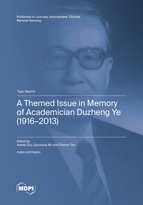Topic Menu
► Topic MenuTopic Editors

A Themed Issue in Memory of Academician Duzheng Ye (1916–2013)

A printed edition is available here.
Topic Information
Dear Colleagues,
This Themed Issue in memory of Academician Duzheng Ye (1916–2013) intends to honor Professor Duzheng Ye, who made numerous significant contributions to Tibetan Plateau meteorology, the theory of atmospheric longwave energy dispersion, climate change adaptation theories, etc., in earth sciences for more than 70 years. He was awarded the nation's highest scientific prize, the State Preeminent Science and Technology Award, in 2005, as well as the 48th International Meteorological Organization (IMO) Prize in 2003. Nearly a decade has passed since 16 October 2013, when Dr. Duzheng Ye passed away at the age of 97. Having finished a PhD study with Prof. Rossby, Dr. Ye returned to China in 1950 and worked at the Institute of Atmospheric Physics, Chinese Academy of Sciences, ever since. Being an academician of the Chinese Academy of Sciences and a pioneer in climate change, Dr. Duzheng Ye is undoubtedly one of the most eminent scientists in atmospheric sciences. Prof. Ye made pioneering contributions to our understanding of the meteorology of the Tibetan Plateau by noting its significant and unique effects on global climate change; formulated the theory of seasonally abrupt change in atmospheric circulation; developed the theory of atmospheric longwave energy dispersion, which has underpinned modern weather forecasting in China; encouraged research on climate change in the earlier years of China’s reform and opening up; and proposed climate change adaptation theories to draw a link between global climate change and human activity by building a framework of “orderly human adaptation” in the context of a life-supporting environment. In honor and recognition of Professor Duzheng Ye’s outstanding career contributions to earth sciences, this Special Issue welcomes the submission of original research manuscripts or reviews featuring, but not limited to, the following topics:
- Atmospheric dynamics and physics;
- Synoptic weather;
- Climate change;
- Remote-sensing observations for weather and climate.
Prof. Dr. Xiaolei Zou
Prof. Dr. Guoxiong Wu
Prof. Dr. Zhemin Tan
Topic Editors
Keywords
- weather and climate dynamics
- atmospheric predictability
- tropical cyclone
- general circulation
- global climate change
- Tibetan Plateau meteorology
- numerical modeling
- satellite data applications in weather and climate
- data assimilation
Participating Journals
| Journal Name | Impact Factor | CiteScore | Launched Year | First Decision (median) | APC |
|---|---|---|---|---|---|

Atmosphere
|
2.9 | 4.1 | 2010 | 17.7 Days | CHF 2400 |

Climate
|
3.7 | 5.2 | 2013 | 19.7 Days | CHF 1800 |

Remote Sensing
|
5.0 | 7.9 | 2009 | 23 Days | CHF 2700 |

MDPI Topics is cooperating with Preprints.org and has built a direct connection between MDPI journals and Preprints.org. Authors are encouraged to enjoy the benefits by posting a preprint at Preprints.org prior to publication:
- Immediately share your ideas ahead of publication and establish your research priority;
- Protect your idea from being stolen with this time-stamped preprint article;
- Enhance the exposure and impact of your research;
- Receive feedback from your peers in advance;
- Have it indexed in Web of Science (Preprint Citation Index), Google Scholar, Crossref, SHARE, PrePubMed, Scilit and Europe PMC.


